
Giulio Alberoni was an Italian cardinal and statesman in the service of Philip V of Spain.

Pope Clement VIII, born Ippolito Aldobrandini, was head of the Catholic Church and ruler of the Papal States from 2 February 1592 to his death, in March 1605.

1598 (MDXCVIII) was a common year starting on Thursday of the Gregorian calendar and a common year starting on Sunday of the Julian calendar, the 1598th year of the Common Era (CE) and Anno Domini (AD) designations, the 598th year of the 2nd millennium, the 98th year of the 16th century, and the 9th year of the 1590s decade. As of the start of 1598, the Gregorian calendar was 10 days ahead of the Julian calendar, which remained in localized use until 1923.

Pope Leo XI, born Alessandro Ottaviano de' Medici, was head of the Catholic Church and ruler of the Papal States from 1 April 1605 to his death, in 27 April 1605. His pontificate is one of the briefest in history, having lasted under a month. He was from the prominent House of Medici originating from Florence. Medici's mother opposed his entering the priesthood and sought to prevent it by having him given secular honours, but after her death he eventually was ordained a priest in 1567. In his career he served as Florence's ambassador to the pope, Bishop of Pistoia, Archbishop of Florence, papal legate to France, and as the cardinal Prefect for the Congregation of the Bishops and Religious. He was elected to the papacy in the March 1605 papal conclave and served as pope for 27 days.
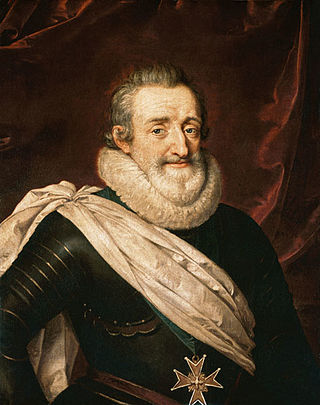
The Edict of Nantes was signed in April 1598 by King Henry IV and granted the minority Calvinist Protestants of France, also known as Huguenots, substantial rights in the nation, which was predominantly Catholic.
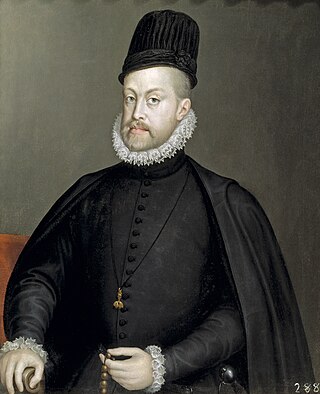
Philip II, also known as Philip the Prudent, was King of Spain from 1556, King of Portugal from 1580, and King of Naples and Sicily from 1554 until his death in 1598. He was also jure uxoris King of England and Ireland from his marriage to Queen Mary I in 1554 until her death in 1558. He was also Duke of Milan from 1540. From 1555, he was Lord of the Seventeen Provinces of the Netherlands.

Henry IV, also known by the epithets Good King Henry or Henry the Great, was King of Navarre from 1572 and King of France from 1589 to 1610. He was the first monarch of France from the House of Bourbon, a cadet branch of the Capetian dynasty. He pragmatically balanced the interests of the Catholic and Protestant parties in France as well as among the European states. He was assassinated in 1610 by a Catholic zealot, and was succeeded by his son Louis XIII.

The French Wars of Religion refers to the period of civil war between French Catholics and Protestants from 1562 to 1598. Between two and four million people died from violence, famine or disease directly caused by the conflict, and it severely damaged the power of the French monarchy. One of its most notorious episodes was the St. Bartholomew's Day massacre in 1572. The fighting ended with a compromise in 1598, when Henry of Navarre, who had converted to Catholicism in 1593, was proclaimed King Henry IV of France and issued the Edict of Nantes, which granted substantial rights and freedoms to the Huguenots. However, Catholics continued to disapprove of Protestants and of Henry, and his assassination in 1610 triggered a fresh round of Huguenot rebellions in the 1620s.
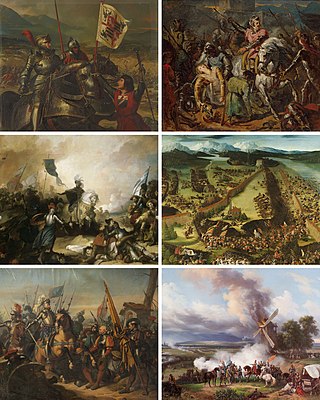
The Italian Wars were a series of conflicts fought between 1494 and 1559, mostly in the Italian peninsula, but later expanding into Flanders, the Rhineland and Mediterranean Sea. The primary belligerents were the Valois kings of France, and their Habsburg opponents in the Holy Roman Empire and Spain. At different points, various Italian states participated in the war, some on both sides, with limited involvement from England and the Ottoman Empire.

Albert VII was the ruling Archduke of Austria for a few months in 1619 and, jointly with his wife, Isabella Clara Eugenia, sovereign of the Habsburg Netherlands between 1598 and 1621. Prior to this, he had been a cardinal, Archbishop of Toledo, viceroy of Portugal and Governor General of the Habsburg Netherlands. He succeeded his brother Matthias as reigning archduke of Lower and Upper Austria, but abdicated in favor of Ferdinand II the same year, making it the shortest reign in Austrian history.

Habsburg Spain is a contemporary historiographical term referring to the huge extent of territories ruled between the 16th and the 18th centuries (1516–1700) by kings from the Spanish branch of the House of Habsburg. Habsburg Spain was a composite monarchy and a personal union. The Habsburg Spanish monarchs reached the zenith of their influence and power ruling the Spanish Empire. Spain, or "the Spains", referring to Spanish territories across different continents in this period, initially covered the entire Iberian peninsula, including the crowns of Castile, Aragon and from 1580 Portugal. It then expanded to include territories over the five continents, consisting of much of Latin America and the West Indies in the Americas, the Low Countries, Belgium, Luxembourg, Italian territories and France in Europe, Portuguese possessions such as small enclaves like Ceuta and Oran in North Africa, and the Philippines and other possessions in Southeast Asia. The period of Spanish history has also been referred to as the "Age of Expansion".
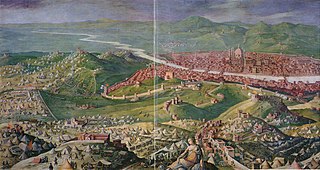
The War of the League of Cognac (1526–30) was fought between the Habsburg dominions of Charles V—primarily the Holy Roman Empire and Spain—and the League of Cognac, an alliance including the Kingdom of France, Pope Clement VII, the Republic of Venice, the Kingdom of England, the Duchy of Milan, and the Republic of Florence.

Pedro Martínez de Luna y Pérez de Gotor, known as el Papa Luna in Spanish and Pope Luna in English, was an Aragonese nobleman who, as Benedict XIII, is considered an antipope by the Catholic Church.

The Italian War of 1551–1559 began when Henry II of France declared war against Holy Roman Emperor Charles V with the intent of recapturing parts of Italy and ensuring French, rather than Habsburg, domination of European affairs. The war ended following the signing of the Treaty of Cateau-Cambrésis between the monarchs of Spain, England and France in 1559. Historians have emphasized the importance of gunpowder technology, new styles of fortification to resist cannon fire, and the increased professionalization of the soldiers.

Giuseppe (Andrea) Albani was an Italian Roman Catholic Cardinal. He played an important role in the elections of Leo XII, Pius VIII and Gregory XVI.

The Invasion of Corsica of 1553 occurred when French, Ottoman, and Corsican exile forces combined to capture the island of Corsica from the Republic of Genoa.
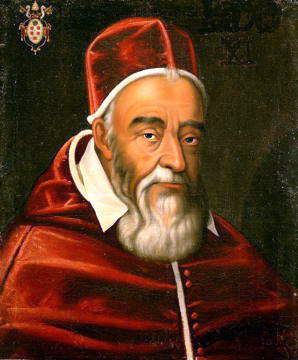
The March–April 1605 papal conclave was convened on the death of Pope Clement VIII and ended with the election of Cardinal Alessandro Ottaviano de' Medici as Pope Leo XI. It was the first of two papal conclaves in 1605; Leo died on 27 April 1605, twenty-six days after he was elected. The conclave was dominated by conflict over whether Cesare Baronius should be elected pope, and Philip III of Spain excluded both Baronius and the eventually successful candidate, Medici.

The siege of Amiens was a siege and battle fought during the Franco-Spanish War (1595–1598), as part of both the French Wars of Religion and the Anglo-Spanish War (1585–1604), between 13 May and 25 September 1597. The Spanish, who had sent a large army in March, had captured the city of Amiens easily in a ruse. Henry IV of France, after the surprise of the capture, immediately and quickly built up an army which included a large English force and besieged Amiens on 13 May.

The Empire of Charles V, also known by the umbrella term Habsburg Empire, included the Holy Roman Empire, the Spanish Empire, the Burgundian Low Countries, the Austrian lands, and all the territories and dominions ruled in personal union by Charles V from 1519 to 1556. It was the first to be labelled as "the empire on which the sun never sets", a term used to describe several global empires throughout history. The lands of the empire had in common only the monarch, Charles V, while their boundaries, institutions, and laws remained distinct. Charles's nomenclature as Holy Roman Emperor was Charles V, though earlier in his life he was known by the names of Charles of Ghent, Charles II as Duke of Burgundy, and Charles I as King of Spain and Archduke of Austria. The imperial name prevailed due to the politico-religious primacy held by the Holy Roman Empire among European monarchies since the Middle Ages, which Charles V intended to preserve as part of his project to unite Christendom under his leadership.

The Treaty of Cateau-Cambrésis or Peace of Cateau-Cambrésis in April 1559 ended the Italian War of 1551–1559, the last of the Italian Wars (1494–1559). It consisted of several separate treaties, the main two signed on 2 April by Elizabeth I of England and Henry II of France, and on 3 April between Henry and Philip II of Spain. Although he was not a signatory, the agreements were approved by Emperor Ferdinand I, since many of the territorial exchanges concerned states that were part of the Holy Roman Empire.




















